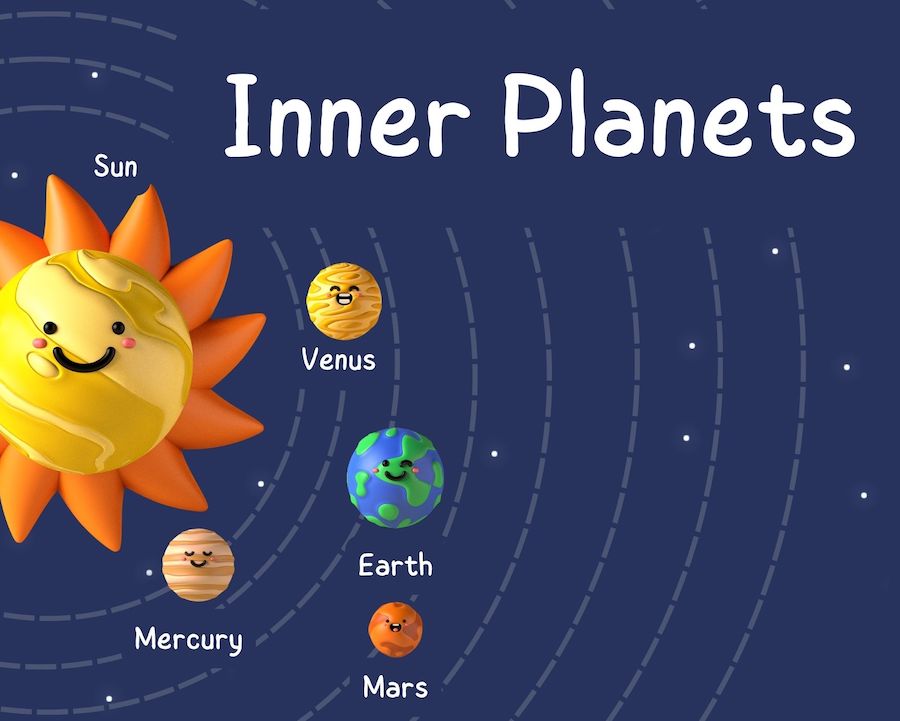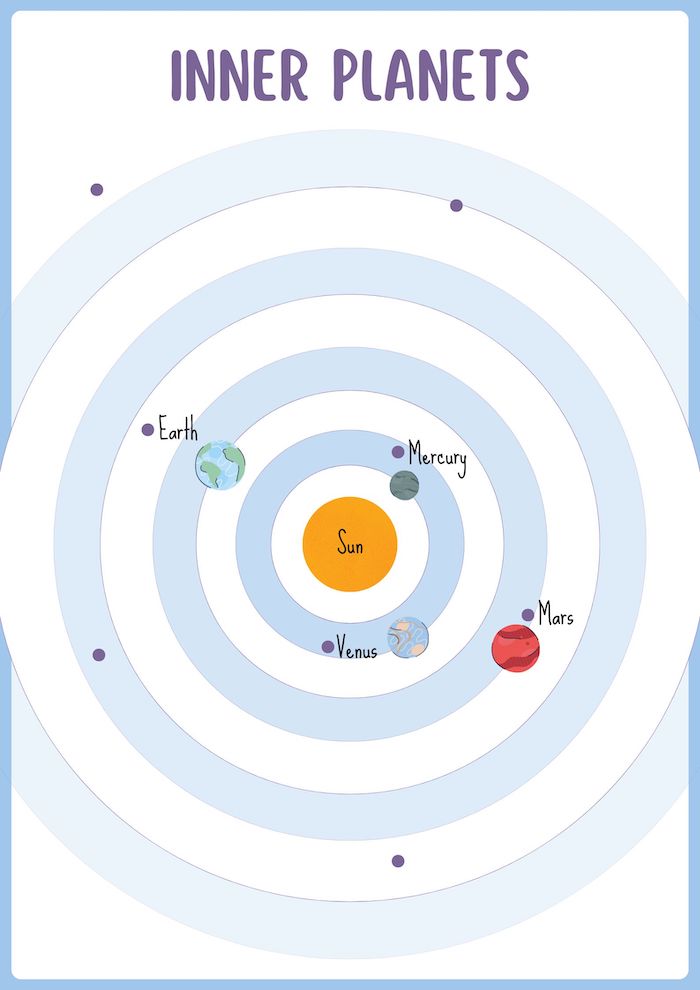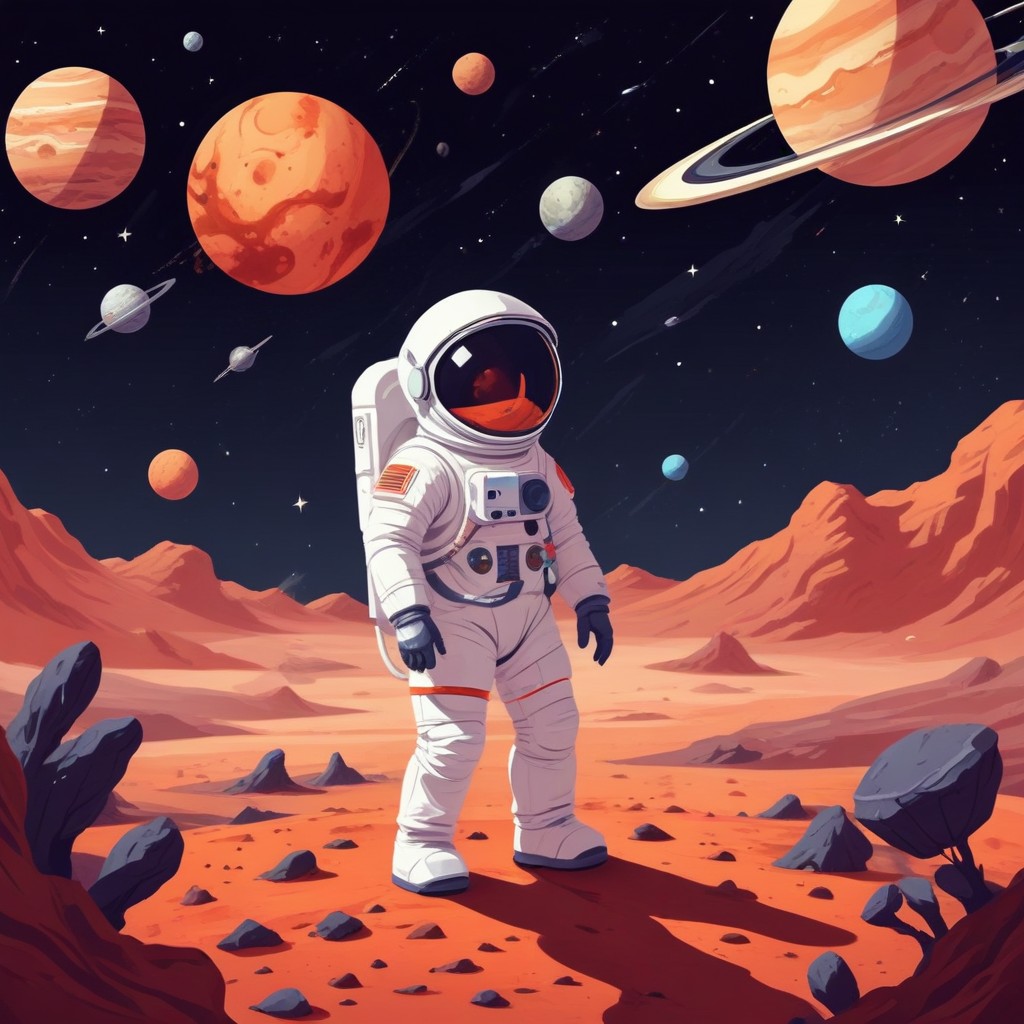The Inner Planets: Learning about our Nearest Neighbors in Space

Hey there, young space explorers! Today, we’re going on an exciting adventure to learn about the inner planets of our solar system. These are the planets that are closest to the Sun. Let’s find out what they are, what they’re made of, and which one is the smallest!
What Are the Inner Planets?
The inner planets are the four planets closest to the Sun. They are:
- Mercury
- Venus
- Earth
- Mars
Remember, these planets are also called the ‘terrestrial planets’ because they have solid, rocky surfaces.

What Are the Inner Planets Made Of?
The inner planets are made mostly of rock and metal. Unlike the outer planets, which are made of gas and ice, the inner planets have solid ground that you could stand on (if you could travel there)!
- Mercury: It’s a rocky planet with a lot of craters, like our Moon. It has a very thin atmosphere, so it gets very hot during the day and very cold at night.This tiny planet is the closest to the Sun. It has a lot of craters on its surface, which are like big holes made by space rocks hitting it.
- Venus: This planet is covered with thick clouds of gas. Its surface is hot enough to melt lead because its atmosphere traps heat. Venus has mountains, volcanoes, and large plains. Venus is the second planet from the Sun and is about the same size as Earth. It has a thick atmosphere that traps heat, making it the hottest planet in our solar system.
- Earth: This is our home! Earth has water, air, and land. It’s the only planet we know that has living things. Earth’s surface has oceans, mountains, forests, and deserts. Our home planet is the third from the Sun.
- Mars: The fourth planet from the Sun is Mars, also known as the “Red Planet” because of its reddish color. Mars has the largest volcano in the solar system and a huge canyon that is deeper than the Grand Canyon. Scientists are very curious about Mars and are exploring it with robots.
Which Inner Planet Is the Smallest?
The smallest inner planet is Mercury. It’s only a little bigger than our Moon! Even though it’s small, it’s very interesting because of its extreme temperatures and craters.
Fun Facts to Remember
- Mercury is the smallest inner planet and the closest to the Sun.
- Venus is the hottest planet because of its thick atmosphere.
- Earth is the only planet where life is known to exist.
- Mars is known for its red color and has the tallest volcano in the solar system, named Olympus Mons.

Why Are the Inner Planets Special?
The inner planets are special because they are the closest to us and have solid surfaces. They teach us a lot about what it means to be a rocky planet and help scientists understand more about our own planet, Earth.
Classroom Resource: Understanding the Inner Planets
This comprehensive classroom resource introduces your students to the fascinating world of the inner planets. Designed to align with educational standards, this resource will help students learn about Mercury, Venus, Earth, and Mars through engaging activities and structured writing exercises.
1. Informational Text: Understanding the Inner Planets
The inner planets of our solar system are Mercury, Venus, Earth, and Mars. These planets are closest to the Sun and are known as terrestrial planets because they have solid, rocky surfaces.
Mercury is the smallest inner planet and is covered with craters. It has extreme temperatures, being very hot during the day and freezing at night due to its thin atmosphere. Venus, the hottest planet, has thick clouds that trap heat. It has mountains and volcanoes on its surface. Earth is unique because it supports life. It has water, air, land, and a variety of climates and ecosystems. Mars, known as the Red Planet, has a reddish appearance due to iron oxide on its surface. It features the tallest volcano and a vast canyon.
These planets are made mostly of rock and metal, unlike the outer planets, which are composed of gases and ice. The inner planets help scientists learn more about planetary formation and the conditions necessary for life.
Comprehension Questions
Multiple Choice Questions:
- Which planet is the smallest inner planet?
- A) Mars
- B) Venus
- C) Mercury
- D) Earth
- What makes Earth unique among the inner planets?
- A) It has the tallest volcano.
- B) It supports life.
- C) It has a thick atmosphere.
- D) It is the hottest planet.
- Why is Mars known as the Red Planet?
- A) Because it is the hottest planet.
- B) Because it is closest to the Sun.
- C) Because of the iron oxide on its surface.
- D) Because of its thick atmosphere.
- What are the inner planets mostly made of?
- A) Gases and ice
- B) Water and air
- C) Rock and metal
- D) Dust and gas
Free Response Questions:
- Describe one characteristic that makes each of the inner planets unique.
- Explain why the inner planets are important for scientists studying planetary formation and the conditions necessary for life.
Writing Exercise: Informative Paragraph
Objective: Students will write an informative paragraph about one of the inner planets, incorporating relevant details and organizing their writing effectively.
Writing Prompt: Choose one of the inner planets (Mercury, Venus, Earth, or Mars). Write an informative paragraph about your chosen planet. Include details about its size, composition, surface features, atmosphere (if applicable), and any other interesting facts. Organize your paragraph logically and use clear, descriptive language.
Instructions:
- Choose one of the inner planets to focus on: Mercury, Venus, Earth, or Mars.
- Research information about your chosen planet using provided resources or other credible sources.
- Use the graphic organizer below to plan your paragraph. Fill in details about your planet’s size, composition, surface features, atmosphere (if applicable), and any other interesting facts.
- Write a draft of your paragraph, incorporating the information from your graphic organizer. Make sure to organize your writing logically and use descriptive language.
- Revise and edit your paragraph for clarity, coherence, and accuracy.
Graphic Organizer:
| Aspect | Details |
|---|---|
| Planet | (Write the name of your chosen planet) |
| Size | (Provide information about the planet’s size compared to Earth) |
| Composition | (Describe what the planet is made of, e.g., rock, metal, etc.) |
| Surface Features | (List any notable features on the planet’s surface, e.g., mountains, craters) |
| Atmosphere | (If applicable, describe the planet’s atmosphere, e.g., thick, thin, toxic gases) |
| Other Interesting Facts | (Include any additional interesting facts about the planet) |
By using this resource, your students will gain a deeper understanding of the inner planets while developing their reading comprehension and writing skills in alignment with CCSS.ELA-LITERACY.W.5.1.b.
The above informational text: Understanding the Inner Planets aligns with the Common Core State Standards for English Language Arts, specifically CCSS.ELA-LITERACY.RI.5.2.
Click here to access more science quizzes.



